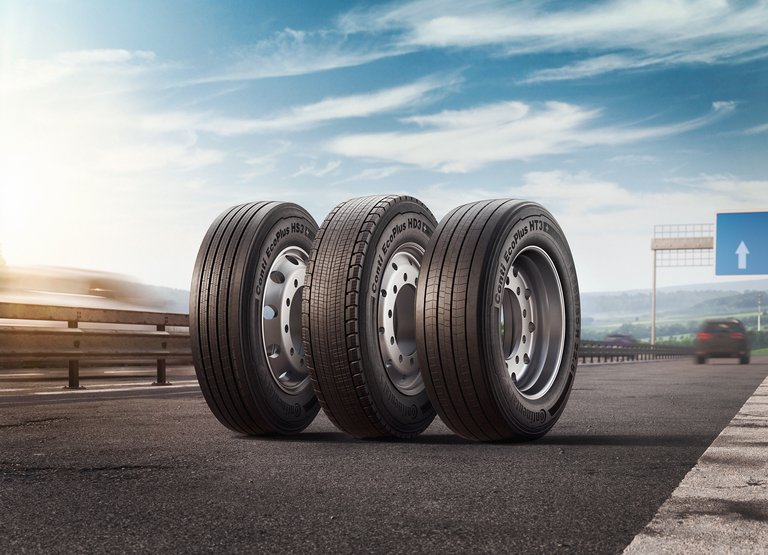Saving Fuel with Continental Tires: Rolling Resistance Makes the Difference
- Soaring prices for gasoline and diesel: sectors and supply chains at risk
- Continental lowers rolling resistance of tires and therefore reduces fuel consumption and CO2 emissions
- Tire Finder, CO2 and fuel calculator, Conti EcoPlus tire range: efficient solutions for fleet operators and trucking companies
Hanover, Germany, April 7, 2022. “Black gold” is how oil and its derivatives are often described. And right now gasoline and diesel really do seem like luxury commodities, as the groans from drivers confronting the high prices at filling stations testify. Unsurprisingly, skyrocketing costs are also giving trucking companies and fleet managers sleepless nights. Logistics associations are even warning of a wave of insolvencies; without fuel the transportation industry would literally grind to a halt. So the emphasis is once again on saving fuel and, by extension, on tires. Indeed, tires are one of various factors playing a central role in fuel consumption. Which explains why Continental has long placed the impact of tires on fuel economy at the heart of its research and development work. The company’s endeavors here are aimed at finding solutions which have a sustained impact on fuel consumption and CO2 emissions.
Lower fuel consumption: how to be cost efficient AND sustainable
According to figures from the EU, around a quarter of Europe’s CO2 emissions in the road traffic and transport sector are caused by heavy commercial vehicles. In order to meet the EU’s climate targets, fleets are being called on to reduce their CO2 emissions by 30 percent by 2030. And cutting CO2 means cutting fuel consumption. In these times of historically high fuel prices, finding ways of saving fuel has become even more important. “The rolling resistance of a tire is responsible for as much as 30 percent of a truck’s fuel consumption and CO2 emissions,” points out Hinnerk Kaiser, Head of Product Development Bus and Truck Tires at Continental.
Tire pressure, vehicle configuration, load distribution, mileage, traction and tire performance are all important criteria in determining fuel consumption and therefore CO2 emissions. However, by far the most important and influential factor is rolling resistance. Here, the task is always to smooth the conflict of interests between low rolling resistance on the one hand and safety-relevant attributes such as grip and handling on the other.
Tread compounds are the key
With this in mind, Continental focuses primarily on tread compounds, which need to generate low friction without negatively impacting grip or mileage. That may sound straightforward, but is far from it. Tires are impacted by various forces during a journey. Indeed, the tread and sidewall of a tire are subjected to bending, buckling and shearing. The constant deformation of a vehicle’s tires and recovery of their original form leads to energy being converted into heat in a process known as hysteresis. “This is one of the main causes of rolling resistance in tires,” explains Kaiser. “With hysteresis, energy is lost in the form of heat. Fuel has to be burned to counteract this effect and maintain the vehicle’s forward momentum.” This shows how important it is to select the right tires for the vehicle’s mission profile, and here Continental is assisting fleet managers with its Tire Finder tool.
Less is more
The relationship between lower rolling resistance and reduced fuel consumption is embodied by the ongoing development of the Conti EcoPlus and Conti EcoRegional tire families. An innovative rubber compound makes it all possible. These premium tires help to reduce fleet costs and CO2 emissions, without compromising on mileage and service life. In mixed regional haulage, in particular, the Eco Regional can offer significant potential for savings, depending on the truck’s usage profile.
VECTO and the EU Emissions Directive are also prominent influencers for the transportation sector when it comes to saving fuel. In order to increase transparency in the tire selection process, Continental has come up with a CO2 and fuel calculator based on the VECTO simulation tool. This calculator allows fleet operators to work out how much they can reduce their emissions and fuel consumption by with the right selection of tires. “We are delighted to be able to offer our customers another tool – in the form of our new calculator – to help them work in a more sustainable way,” says Enno Straten, Head of Marketing Replacement Tires EMEA at Continental.
The interplay of correct tire choice, tire construction, tire pressure and rolling resistance is critical in determining how much a fleet of vehicles use and how much they can save. The high fuel prices we are seeing at present and growing demands for reductions in CO2 emissions and increased sustainability are shining the spotlight on the issue of fuel saving – through the lens of economics, the impact on livelihoods, supply chains and, not least, the environment. And Continental is offering solutions which can help overcome these challenges with the input of fleet managers.
Follow this link to the Continental video “Why rolling resistance matters”.

Annette Rojas
Spokesperson commercial vehicle tires
Public Relations, Media and Communication
Replacement Tires EMEA
Continental Reifen Deutschland GmbH




